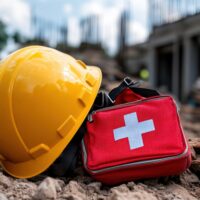The Most Dangerous Types of Construction Accidents in New York

Construction is one of the most hazardous industries in New York. Despite state and federal safety regulations, serious accidents continue to occur. These incidents often result in catastrophic injuries or fatalities, particularly when basic safety protocols are ignored or safety equipment is lacking.
At Rusk, Wadlin, Heppner & Martuscello, LLP, we represent injured construction workers and their families in personal injury claims arising from some of the most dangerous types of construction accidents. Below we discuss several of the most severe and life-threatening accidents that can occur on a construction site. If you or a loved one were injured in a construction accident in Ulster County or the Hudson Valley, contact Rusk, Wadlin, Heppner & Martuscello, LLP, to speak with a dedicated Kingston construction accident lawyer.
Falls from Heights
Falls are consistently the leading cause of death in the construction industry. Workers who operate on ladders, scaffolds, rooftops, or elevated platforms face a heightened risk of falling, especially when fall protection systems are missing or defective.
Under New York’s Labor Law § 240—commonly known as the Scaffold Law—contractors and property owners can be held strictly liable when a worker falls due to inadequate safety devices. Injuries from these accidents often include traumatic brain injuries, spinal cord damage, and multiple fractures.
Being Struck by Falling Objects
Another high-risk scenario involves being struck by tools, debris, or materials falling from above. Construction sites are dynamic environments, and tools or materials can fall from scaffolding, cranes, or incomplete structures.
Even with hard hats, the force of a falling object can cause serious injuries such as skull fractures, concussions, and internal bleeding. These accidents are often preventable through the proper securing of equipment and enforcement of overhead hazard protocols. The Scaffold Law applies to these gravity-related accidents as well, imposing absolute liability on building owners and contractors.
Trench Collapses
Excavation work poses a particular danger when trenches are improperly supported. A trench collapse can bury a worker under thousands of pounds of soil in seconds, leading to crush injuries, suffocation, or death.
OSHA regulations require protective systems such as trench boxes or shoring to prevent cave-ins, but these safeguards are not always followed, especially under tight construction deadlines. Employers and contractors who cut corners to save time or money place their workers in grave danger.
Crane and Heavy Equipment Accidents
Cranes, bulldozers, forklifts, and other heavy machinery are essential tools on many construction sites, but they also present significant hazards. Improper operation, lack of training, or mechanical failures can result in workers being struck, pinned, or run over by equipment.
Crane collapses, for example, can affect not only those on the ground but also operators and people working in adjacent buildings. These accidents tend to cause devastating injuries due to the sheer size and weight of the machinery involved.
Electrocution Accidents
Electrical hazards are another leading cause of fatal construction site incidents. Contact with exposed wiring, power lines, or improperly grounded equipment can cause severe burns, cardiac arrest, or death.
New York construction workers often operate in environments where electricity is present but not yet properly routed or insulated. Employers are responsible for ensuring that power sources are clearly marked, de-energized when appropriate, and safely maintained.
Caught-In or Caught-Between Incidents
Caught-in/between accidents occur when a worker becomes trapped in or compressed by machinery, collapsing structures, or between moving parts. These incidents are frequently fatal or result in traumatic amputations and crush injuries.
Examples include a worker caught in a rotating drill, pinned between a truck and a wall, or trapped by a collapsing foundation wall. These accidents often result from failure to install machine guards, inadequate lockout/tagout procedures, or insufficient training.
Explosions and Fires
While less frequent, explosions and fires on construction sites are particularly deadly. They can be triggered by gas leaks, chemical spills, or electrical malfunctions. Workers in proximity to the explosion may suffer burn injuries, lung damage from inhaling toxic smoke, or blunt force trauma from the blast.
These types of accidents are more common during demolition, renovation, or when working near flammable substances.
Legal Protections for Injured New York Construction Workers
In New York, injured construction workers have legal options beyond workers’ compensation. State labor laws—specifically Labor Law §§ 200, 240, and 241(6)—permit workers to pursue claims against property owners, contractors, or equipment manufacturers and other third parties for failing to maintain a safe job site.
These laws provide critical protection and often result in significantly greater financial recovery than workers’ comp alone, particularly when the injury results in long-term disability or the inability to return to work.
We Help Ulster County Construction Workers Rebuild After Injury
At Rusk, Wadlin, Heppner & Martuscello, LLP, we understand how a serious construction accident can derail your life. We represent injured workers throughout Kingston, Ulster County, and the Hudson Valley in personal injury claims involving some of the most dangerous construction accidents.
Our firm thoroughly investigates the cause of the accident, identifies all liable parties, and pursues maximum compensation for medical expenses, lost income, and pain and suffering. If you or someone you love has been seriously injured on a New York construction site, contact us for a free consultation.